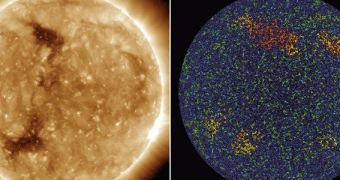Researchers operating the NASA Solar Dynamics Observatory (SDO) were recently able to develop a method for tracking the flow of material underneath the surface of the Sun, a capability that will improve our understanding of how our parent star works. Solar physicists also hope to gain new insights into how and why solar flares and coronal mass ejections (CME) occur.
The first author of the new study was chromosphere dynamics expert Dr. Scott McIntosh, who holds an appointment with the High Altitude Observatory at the US National Center for Atmospheric Research (NCAR). Montana State University researcher Robert Leamon, also based at NASA Headquarters in Washington, DC, was a coauthor on the paper, which appears in the Astrophysical Journal Letters.
The team says that their latest study identified a series of so-called tracers, or bright spots, in the solar atmosphere that could help them track the flow of material underneath the star's surface. Keeping tabs on the magnetic signatures that develop on the Sun's surface can be used in conjunction with tracer analysis to reveal more about the inner workings of the star.
According to the science group, this new technique could be used to produce maps of the solar interior almost in real-time. This would allow physicists to better track and monitor the phenomena and processes that lead to the formation of solar flares, CME, and that cause the 22-year sunspot cycles on the star. “There are all sorts of things lurking below the surface,” McIntosh explains.
“And we've found a marker for this deep rooted activity. This is kind of a gateway to the interior, and we don't need months of data to get there,” the investigator goes on to say. Until now, the only method researchers could use to prove the solar interior was helioseismology, a technique that tracked seismic wave-like patterns on the solar surface to reveal activities deep beneath.
Thus far, helioseismology has enabled experts to determine that the interior of the Sun is made up of structures called granules and super-granules, which interact with each other to produce the effects we see on its surface. A granule is as large as the entire United States, while a super-granule can be up to twice the diameter of our entire planet.
Data obtained through helioseismology techniques can now be augmented with observations carried out via the Helioseismic Magnetic Imager (HMI) instrument on SDO, which sees the magnetic fields on and around the star. By analyzing data collected over several years, the team established that the magnetic “parcels” HMI sees correspond to the size of the granules and super-granules underneath.
“Imagine a bunch of helium balloons with weights on them. The weights get carried along by the motions at the bottom. We can track the motion of the helium balloons floating up high and that tells us what's happening down below,” Leamon concludes.

 14 DAY TRIAL //
14 DAY TRIAL //